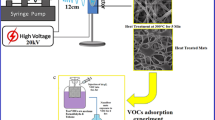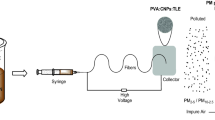Abstract
The article reports a two-step synthesis of composite nanofibrous mats of polytetraflouroethylene/zinc oxide (PTFE-ZnO); first, emulsion electrospinning of precursor solution was performed to yield as-spun mats followed by heat treatment at 280 °C. The surface of pure PTFE nanofibrous mats was modified by varying the amount of ZnO loadings in the electrospinning solution from 10 to 20 wt.%. Physiochemical characterization of synthesized mats was performed by FESEM, EDX, AFM, FTIR, Raman, TGA and contact angle goniometry. It was observed that fiber mean diameter decreased from 0.243 ± 15.10 μm to 0.17 ± 30.50 μm, RMS roughness increased from 112 to 627 nm and CA improved from 102.56° to 121.55° with the rise in ZnO content up to 20 wt% compared to the pure PTFE mats. Higher surface area, roughness and hydrophobicity of PTFE-ZnO mats resulted into significantly enhanced adsorption ability of VOCs on their surfaces against three model VOCs, namely, toluene, acetone and formaldehyde. The results have demonstrated that surface adsorption capacity of tested VOCs has considerably increased to 10, 07 and 03 folds respectively for the nanofibrous mats containing 20 wt.% ZnO, compared to pure PTFE mats. Based on these findings, these nanofibrous mats can potentially be used as filters for VOCs and particulate removal from air in the processing industries.










Similar content being viewed by others
References
Ge J, Choi N (2017) Fabrication of functional polyurethane/rare earth nanocomposite membranes by electrospinning and its VOCs absorption capacity from air. Nanomaterials 7:60
Mirzaei A, Leonardi S, Neri G (2016) Detection of hazardous volatile organic compounds (VOCs) by metal oxide nanostructures-based gas sensors: a review. Ceram Int 42:15119–15141
Temel F, Tabakci M (2016) Calix [4] arene coated QCM sensors for detection of VOC emissions: methylene chloride sensing studies. Talanta 153:221–227
Bartzis J, Wolkoff P, Stranger M, Efthimiou G, Tolis E, Maes F et al (2015) On organic emissions testing from indoor consumer products’ use. J Hazard Mater 285:37–45
Wang Y, Tao H, Yu D, Chang C (2018) Performance assessment of ordered porous electrospun honeycomb fibers for the removal of atmospheric polar volatile organic compounds. Nanomaterials 8:350
Vellingiri K, Kumar P, Deep A, Kim K-H (2017) Metal-organic frameworks for the adsorption of gaseous toluene under ambient temperature and pressure. Chem Eng J 307:1116–1126
Pokharel P (2014) High performance polyurethane nanocomposite films prepared from a masterbatch of graphene oxide in polyether polyol. Chem Eng J 253:356–365
Fayaz M, Shariaty P, Atkinson JD, Hashisho Z, Phillips JH, Anderson JE, Nichols M (2015) Using microwave heating to improve the desorption efficiency of high molecular weight VOC from beaded activated carbon. Environ Sci Technol 49:4536–4542
Feng Y, Xiong T, Xu H, Li C, Hou H (2016) Polyamide-imide reinforced polytetrafluoroethylene nanofiber membranes with enhanced mechanical properties and thermal stabilities. Mater Lett 182:59–62
Sun J, Liu X, Liang Y, Wang L, Liu Y (2017) The preparation of microcrystalline cellulose–nanoSiO2 hybrid materials and their application in tire tread compounds. J Appl Polym Sci 134
Qamar Z, Zakria M, Shakoor RI, Raffi M, Mehmood M, Mahmood A (2017) Reinforcement of electroactive characteristics in polyvinylidene fluoride electrospun nanofibers by intercalation of multi-walled carbon nanotubes. J Polym Res 24:39
Scholten E, Bromberg L, Rutledge GC, Hatton TA (2011) Electrospun polyurethane fibers for absorption of volatile organic compounds from air. ACS Appl Mater Interfaces 3:3902–3909
Kim HJ, Pant HR, Choi NJ, Kim CS (2013) Composite electrospun fly ash/polyurethane fibers for absorption of volatile organic compounds from air. Chem Eng J 230:244–250
Ahmad MR, Yahya MF (2014) Proceedings of the International Colloquium in Textile Engineering, Fashion, Apparel and Design 2014 (ICTEFAD 2014): Springer
Sun L, Zhu J, Che Y, Li Q, Guo W, Wu C (2018) Fabrication of high-performance polytetrafluoroethylene microporous membranes filled with nano-alumina. High Perform Polym, p. 0954008318804034
Zhang Y, Kou K, Zhang S, Ji T (2019) Improving thermal properties of ultrafine-glass-fiber reinforced PTFE hybrid composite via surface modification by (3-aminopropyl) triethoxysilane. J Polym Res 26:214
Xiao K, Sun J, Mo Y, Fang Z, Liang P, Huang X, Ma J, Ma B (2014) Effect of membrane pore morphology on microfiltration organic fouling: PTFE/PVDF blend membranes compared with PVDF membranes. Desalination 343:217–225
Xu H, Jin W, Wang F, Liu G, Li C, Wang J, Zhu H, Guo Y (2019) Formation and characterization of polytetrafluoroethylene nanofiber membranes for high-efficiency fine particulate filtration. RSC Adv 9:13631–13645
Mao N, Liu J, Chang D, Sun X (2015) Discussion of influencing factors on filtration performances of PTFE membrane filters, in 2015 International Symposium on Computers & Informatics
Nan Z, Xiang-yu J, Chen H, Qin-fei K (2017) Improved filtration properties of hydroentangled PTFE/PPS fabric filters caused by fibrillation
Wang X, Gao J, Zhang J, Zhang X, Guo R (2015) Theoretical and experimental studies on acetylene absorption in a Polytetrafluoroethylene hollow-Fiber membrane contactor. Chem Eng Technol 38:215–222
Zhang C, Yuan X, Wu L, Han Y, Sheng J (2005) Study on morphology of electrospun poly (vinyl alcohol) mats. Eur Polym J 41:423–432
Rwei S-P, Huang C-C (2012) Electrospinning PVA solution-rheology and morphology analyses. Fibers Polym 13:44–50
Reshmi C, Sundaran SP, Juraij A, Athiyanathil S (2017) Fabrication of superhydrophobic polycaprolactone/beeswax electrospun membranes for high-efficiency oil/water separation. RSC Adv 7:2092–2102
R. C. R, S. P. Sundaran, J. A, and S. Athiyanathil (2017) Fabrication of superhydrophobic polycaprolactone/beeswax electrospun membranes for high-efficiency oil/water separation. RSC Advances, 7, 2092–2102
Kadam V, Truong YB, Easton C, Mukherjee S, Wang L, Padhye R, Kyratzis IL (2018) Electrospun Polyacrylonitrile/β-Cyclodextrin composite membranes for simultaneous air filtration and adsorption of volatile organic compounds. ACS Appl Nano Mater 1:4268–4277
Huang Q-L, Huang Y, Xiao C-F, You Y-W, Zhang C-X (2017) Electrospun ultrafine fibrous PTFE-supported ZnO porous membrane with self-cleaning function for vacuum membrane distillation. J Membr Sci 534:73–82
Ramesh Kumar P, Khan N, Vivekanandhan S, Satyanarayana N, Mohanty A, Misra M (2012) Nanofibers: effective generation by electrospinning and their applications. J Nanosci Nanotechnol 12:1–25
Nataraj S, Kim B, Yun J, Lee D, Aminabhavi T, Yang K (2008) Electrospun nanocomposite fiber mats of zinc-oxide loaded polyacrylonitrile. Carbon Lett 9:108–114
Ahmed R, Tariq M, Ali I, Asghar R, Khanam PN, Augustine R et al (2018) Novel electrospun chitosan/polyvinyl alcohol/zinc oxide nanofibrous mats with antibacterial and antioxidant properties for diabetic wound healing. Int J Biol Macromol 120:385–393
Huang Y, Huang Q-L, Liu H, Zhang C-X, You Y-W, Li N-N, Xiao CF (2017) Preparation, characterization, and applications of electrospun ultrafine fibrous PTFE porous membranes. J Membr Sci 523:317–326
Liang Y, Ju J, Deng N, Zhou X, Yan J, Kang W, Cheng B (2018) Super-hydrophobic self-cleaning bead-like SiO2@ PTFE nanofiber membranes for waterproof-breathable applications. Appl Surf Sci 442:54–64
Zhu X, Feng S, Zhao S, Zhang F, Xu C, Hu M et al (2020) Perfluorinated superhydrophobic and oleophobic SiO2@PTFE nanofiber membrane with hierarchical nanostructures for oily fume purification. J Membr Sci 594:117473
Hondred PR, Yoon S, Bowler N, Kessler MR (2013) Degradation kinetics of polytetrafluoroethylene and poly (ethylene-alt-tetrafluoroethylene). High Perform Polym 25:535–542
Odochian L, Moldoveanu C, Maftei D (2014) TG–FTIR study on thermal degradation mechanism of PTFE under nitrogen atmosphere and in air. Influence of the grain size. Thermochim Acta 598:28–35
Li X, Wang X-X, Yue T-T, Xu Y, Zhao M-L, Yu M, Ramakrishna S, Long YZ (2019) Waterproof-breathable PTFE nano- and microfiber membrane as high efficiency PM2.5 filter. Polymers 11:590
Kang W, Li F, Zhao Y, Qiao C, Ju J, Cheng B (2016) Fabrication of porous Fe 2 O 3/PTFE nanofiber membranes and their application as a catalyst for dye degradation. RSC Adv 6:32646–32652
Koenig JL, Boerio FJ (1969) Raman scattering and band assignments in Polytetrafluoroethylene. J Chem Phys 50:2823–2829
Kereszturi K, Szabó A, Tóth A, Marosi G, Szépvölgyi J (2008) Surface modification of poly (tetrafluoroethylene) by saddle field fast atom beam source. Surf Coat Technol 202:6034–6037
Khan A (2010) Raman Spectroscopic Study of the ZnO Nanostructures. J Pak Mater Soc 1
Bhunia A, Jha PK, Rout D, Saha S (2016) Morphological Properties and Raman Spectroscopy of ZnO Nanorods. J Physic Sci 21
Gültekin D, Akbulut H (2016) Raman studies of ZnO products synthesized by solution based methods. Acta Phys Pol A 129:803–805
Horzum N, Tascioglu D, Özbek C, Okur S, Demir MM (2014) VOC sensors based on a metal oxide nanofibrous membrane/QCM system prepared by electrospinning. New J Chem 38:5761–5768
Simpson JT, Hunter SR, Aytug T (2015) Superhydrophobic materials and coatings: a review. Rep Prog Phys 78:086501
Tran PA, Webster TJ (2013) Understanding the wetting properties of nanostructured selenium coatings: the role of nanostructured surface roughness and air-pocket formation. Int J Nanomedicine 8:2001–2009
Wang B, Zhang Y, Shi L, Li J, Guo Z (2012) Advances in the theory of superhydrophobic surfaces. J Mater Chem 22:20112–20127
Choi DY, Heo KJ, Kang J, An EJ, Jung S-H, Lee BU, Lee HM, Jung JH (2018) Washable antimicrobial polyester/aluminum air filter with a high capture efficiency and low pressure drop. J Hazard Mater 351:29–37
Nugraha N, Saputro AG, Agusta MK, Akbar FT, Pramudya AD (2019) Density functional study on benzene, toluene, Ethylbenzene and xylene adsorptions on ZnO (100) surface. Molekul 14:37–47
Jiye H, Xiaoyu L, Yiqiu F, Songhai X, Yan P, Minghua Q et al (2013) Physically mixed ZnO and skeletal NiMo for one-pot reforming-hydrogenolysis of glycerol to 1, 2-propanediol. Chin J Catal 34:1020–1026
Sharma N, Sharma N, Srinivasan P, Kumar S, Rayappan JBB, Kailasam K (2018) Heptazine based organic framework as a chemiresistive sensor for ammonia detection at room temperature. J Mater Chem A 6:18389–18395
Acknowledgements
The authors would like to sincerely thank and acknowledge the valuable technical support extended by the Institute of Space Technology (IST), Pakistan Institute of Engineering and Applied Sciences (PIEAS), Higher Education Commission (HEC), Islamabad, Pakistan and University of Florida, FL, United States of America for completion of this research work.
Author information
Authors and Affiliations
Corresponding author
Ethics declarations
Conflict of interest
The authors would like to firmly declare that there is no conflict of interest among them on manuscript preparation, financial matters, intellectual property rights, personal considerations and any other competing interests which might be directly or indirectly tied to this research for publication.
Additional information
Publisher’s note
Springer Nature remains neutral with regard to jurisdictional claims in published maps and institutional affiliations.
Rights and permissions
About this article
Cite this article
Mazhar, S.I., Shafi, H.Z., Shah, A. et al. Synthesis of surface modified hydrophobic PTFE-ZnO electrospun nanofibrous mats for removal of volatile organic compounds (VOCs) from air. J Polym Res 27, 222 (2020). https://doi.org/10.1007/s10965-020-02218-x
Received:
Accepted:
Published:
DOI: https://doi.org/10.1007/s10965-020-02218-x




